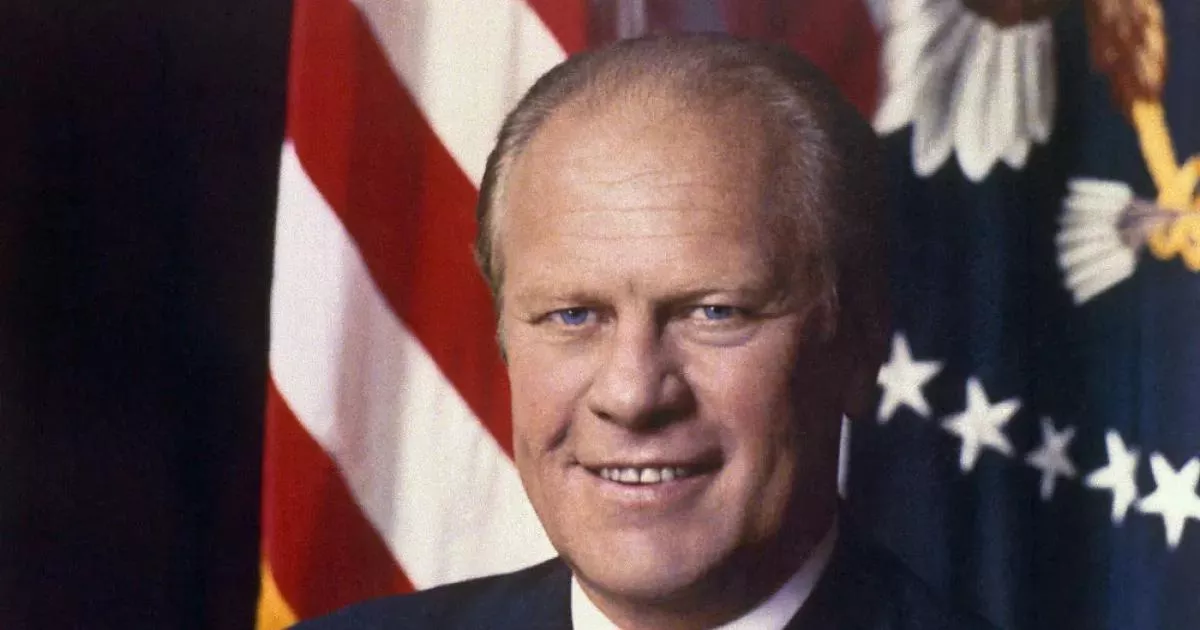Gerald Ford, the 38th U.S. President, served from 1974-1977. A Republican, he ascended to the presidency after Richard Nixon's resignation, having previously served as Nixon's Vice President following Spiro Agnew's resignation. Before becoming Vice President, Ford was a member of the U.S. House of Representatives from 1949 to 1973. His presidency was largely defined by his controversial pardon of Nixon and efforts to combat inflation during an economic downturn.
July 14, 1913: Birth of Gerald Ford
On July 14, 1913, Gerald Rudolph Ford Jr., originally named Leslie Lynch King Jr., was born in Omaha, Nebraska.
July 14, 1913: Birth of Leslie Lynch King Jr.
On July 14, 1913, Leslie Lynch King Jr., who later became Gerald Ford, was born in Omaha, Nebraska.
December 1913: Divorce of Ford's Parents
In December 1913, Dorothy Ayer Gardner and Leslie Lynch King Sr. divorced, and Dorothy gained full custody of her son, Leslie.
1915: Burdick v. United States Decision
In 1915, the U.S. Supreme Court made a decision in Burdick v. United States, which stated that a pardon indicated a presumption of guilt, and that acceptance of a pardon was tantamount to a confession of that guilt.
February 1, 1917: Gardner Married Gerald Rudolff Ford
On February 1, 1917, Dorothy Ayer Gardner married Gerald Rudolff Ford, and her son was then referred to as Gerald Rudolff Ford Jr.
1918: Birth of Thomas Gardner "Tom" Ford
In 1918, Thomas Gardner "Tom" Ford, one of Gerald Ford's half-brothers, was born.
1924: Birth of Richard Addison "Dick" Ford
In 1924, Richard Addison "Dick" Ford, one of Gerald Ford's half-brothers, was born.
August 1927: Ford Became an Eagle Scout
In August 1927, Gerald Ford earned the rank of Eagle Scout, the highest rank in the Boy Scouts of America.
1927: Birth of James Francis "Jim" Ford
In 1927, James Francis "Jim" Ford, one of Gerald Ford's half-brothers, was born.
1930: Death of Ford's Paternal Grandfather
In 1930, Ford's paternal grandfather, who had been paying child support, passed away.
1930: Ford Selected to All-City Team
In 1930, Gerald Ford was selected to the All-City team of the Grand Rapids City League.
1932: Michigan Won National Title
In 1932, Gerald Ford played on the University of Michigan football team, which had an undefeated season and won a national title.
1933: Michigan Won National Title
In 1933, Gerald Ford played on the University of Michigan football team, which had an undefeated season and won a national title.
1934: Ford Played for Michigan
In 1934, Gerald Ford was a star player for the University of Michigan football team, during which they held Minnesota to a scoreless tie in the first half of one game.
1934: Ford selected for Shriners' East-West Shrine Game
In 1934, Gerald Ford was selected for the Eastern Team in the Shriners' East–West Shrine Game at San Francisco, which was played on January 1, 1935, to benefit physically disabled children.
January 1, 1935: Ford Played in Shriners' East-West Shrine Game
On January 1, 1935, Gerald Ford played in the Shriners' East–West Shrine Game at San Francisco as part of the Eastern Team.
September 1935: Ford Took Job at Yale University
In September 1935, Gerald Ford took a job as the boxing coach and assistant varsity football coach at Yale University.
December 3, 1935: Ford's Name Change Formalized
On December 3, 1935, the name change to Gerald Rudolff Ford Jr. was formalized.
1935: Ford Hopes to Attend Yale Law School
In 1935, Gerald Ford hoped to attend Yale Law School, but his admission was initially denied due to his coaching responsibilities.
1937: Ford at University of Michigan Law School
In the summer of 1937, Gerald Ford spent time as a student at the University of Michigan Law School.
1938: Ford Admitted to Yale Law School
In the spring of 1938, Gerald Ford was admitted to Yale Law School and was also promoted to the position of junior varsity head football coach at Yale.
1939: Ford Signed Petition to Enforce Neutrality Act
In 1939, Gerald Ford joined a group of students and signed a petition to enforce the 1939 Neutrality Act, inspiring the America First Committee.
1940: Ford Worked for Wendell Willkie
In the summer of 1940, Gerald Ford began his introduction to politics when he worked for the Republican presidential campaign of Wendell Willkie.
May 1941: Ford Opened Law Practice
In May 1941, Gerald Ford opened a law practice in Grand Rapids with Philip W. Buchen.
December 7, 1941: Attack on Pearl Harbor
Following the December 7, 1941, attack on Pearl Harbor, Ford enlisted in the Navy.
1941: Ford Modeled for Harry Conover agency
Until 1941, Gerald Ford worked as a model with the Harry Conover agency.
April 13, 1942: Ford Commissioned as Ensign
On April 13, 1942, Gerald Ford received a commission as ensign in the U.S. Naval Reserve.
June 2, 1942: Ford Promoted to Lieutenant
On June 2, 1942, Gerald Ford was promoted to Lieutenant, Junior Grade, at the Navy Preflight School.
1942: Ford Served in U.S. Naval Reserve
From 1942 to 1946, Gerald Ford served in the U.S. Naval Reserve.
March 1943: Ford Promoted to Lieutenant
In March 1943, Gerald Ford was promoted to lieutenant at the Navy Preflight School.
May 1943: Ford Sent to USS Monterey
In May 1943, Gerald Ford was sent to the pre-commissioning detachment for the new aircraft carrier USS Monterey (CVL-26).
June 17, 1943: USS Monterey Commissioned
From the USS Monterey's commissioning on June 17, 1943, until the end of December 1944, Gerald Ford served as the assistant navigator, Athletic Officer, and antiaircraft battery officer.
November 1944: Monterey Launched Strikes
From September to November 1944, aircraft from the USS Monterey launched strikes against Wake Island, participated in strikes in the Philippines and Ryukyus, and supported the landings at Leyte and Mindoro.
December 1944: Ford Served on USS Monterey
From the ship's commissioning on June 17, 1943, until the end of December 1944, Gerald Ford served as the assistant navigator, Athletic Officer, and antiaircraft battery officer on board the Monterey.
1944: USS Monterey Damaged by Typhoon Cobra
In 1944, the USS Monterey, where Ford was serving, was damaged by Typhoon Cobra, which caused a fire and significant damage to the ship.
April 1945: Ford Assigned to Athletic Department
After the fire, the USS Monterey was declared unfit for service. Ford was detached from the ship and sent to the Navy Pre-Flight School at Saint Mary's College of California, where he was assigned to the Athletic Department until April 1945.
January 1946: Ford on Staff of Naval Reserve Training Command
From the end of April 1945 to January 1946, Gerald Ford was on the staff of the Naval Reserve Training Command, Naval Air Station, Glenview, Illinois, at the rank of lieutenant commander.
February 1946: Ford Honorably Discharged
In February 1946, Gerald Ford was honorably discharged from the Navy after receiving several military awards.
1946: Return to Grand Rapids and Republican Politics
In 1946, Gerald Ford returned to Grand Rapids and became involved in local Republican politics. Supporters encouraged him to challenge the incumbent Republican congressman, Bartel J. Jonkman, because Ford's military service had changed his worldview to an internationalist perspective, contrasting with Jonkman's isolationist views.
1948: First Congressional Campaign
In 1948, during his first campaign for Congress, Ford engaged directly with voters by visiting them at their homes and at factories. He also visited local farms, where he made a wager that resulted in him spending two weeks milking cows after his election victory.
1949: Ford Joined U.S. House of Representatives
In 1949, Gerald Ford became a member of the U.S. House of Representatives.
1949: Ford Became U.S. Representative
In 1949, Gerald Ford started his political career as the U.S. representative from Michigan's 5th congressional district.
1957: Civil Rights Act Vote
In 1957, Ford voted in favor of the Civil Rights Act.
1960: Civil Rights Act Vote
In 1960, Ford voted in favor of the Civil Rights Act.
1960: Televised Presidential Debates Reintroduced
In 1960, Televised presidential debates were reintroduced for the first time.
November 29, 1963: Appointment to the Warren Commission
On November 29, 1963, President Lyndon B. Johnson appointed Ford to the Warren Commission, which investigated the assassination of President John F. Kennedy. Ford was tasked with preparing a biography of Lee Harvey Oswald.
1964: Civil Rights Act Vote
In 1964, Ford voted in favor of the Civil Rights Act.
1964: Selection as House Minority Leader
In 1964, following Republican losses in the House of Representatives, Gerald Ford was chosen to replace Charles Halleck as the House Minority Leader after being approached by multiple members to consider the position. The group was later known as the 'Young Turks'.
1965: Start of Tenure as Minority Leader
In 1965, Gerald Ford started his tenure as minority leader in the House of Representatives.
1966: Growing Criticism of Vietnam War Handling
In 1966, criticism grew over the Johnson Administration's handling of the Vietnam War, with Ford and Congressional Republicans expressing concern that the United States was not doing enough to win the war. The 1966 midterm elections resulted in a 47-seat swing in favor of the Republicans.
November 1968: Shift to Advocate for the White House Agenda
After Richard Nixon was elected president in November 1968, Ford's role shifted to being an advocate for the White House agenda.
1968: Civil Rights Act Vote
In 1968, Ford voted in favor of the Civil Rights Act.
1969: Passage of Nixon's Proposals
In 1969, Congress passed several of Nixon's proposals, including the National Environmental Policy Act and the Tax Reform Act.
1972: Passage of State and Local Fiscal Assistance Act
In 1972, the State and Local Fiscal Assistance Act, which established a revenue sharing program for state and local governments, was passed. Ford's leadership was instrumental in shepherding revenue sharing through Congress.
October 10, 1973: Spiro Agnew Resignation
On October 10, 1973, Spiro Agnew resigned from the vice presidency, leading to Nixon seeking advice on a replacement.
December 1973: Ford Appointed Vice President
In December 1973, Gerald Ford was appointed as the Vice President of the United States following Spiro Agnew's resignation.
1973: Ford Became Vice President
In 1973, Gerald Ford became the 40th Vice President of the United States, following Spiro Agnew's resignation.
1973: End of House of Representatives Tenure
In 1973, Gerald Ford concluded his 25-year tenure in the House of Representatives, representing Michigan's 5th congressional district.
1973: End of Tenure as Minority Leader
In 1973, Gerald Ford ended his tenure as minority leader in the House of Representatives.
August 1, 1974: Warning about potential Presidency
On August 1, 1974, Alexander Haig contacted Ford to tell him to prepare for the presidency due to a new tape being released with devastating evidence that would probably lead to either an impeachment or a resignation of the president.
August 9, 1974: Assumption of the Presidency
On August 9, 1974, Gerald Ford assumed the presidency automatically after Nixon's resignation, making him the only person to become the nation's chief executive without being elected to the presidency or the vice presidency.
August 1974: Ford Assumed the Presidency
In August 1974, Gerald Ford immediately assumed the presidency after Richard Nixon's resignation.
September 8, 1974: Pardon of Richard Nixon
On September 8, 1974, Ford issued Proclamation 4311, granting Richard Nixon a full and unconditional pardon for any crimes he might have committed against the United States while president.
September 30, 1974: Creation of Economic Policy Board
On September 30, 1974, President Ford created the Economic Policy Board by Executive Order to address economic concerns during his administration.
October 4, 1974: Ford's Speech to Congress Kicking Off "WIN" Campaign
On October 4, 1974, Ford delivered a speech to a joint session of Congress to officially kick off the "WIN" campaign, aimed at curbing inflation and introducing a tax increase proposal.
October 1974: Launch of "Whip Inflation Now" (WIN) Campaign
In October 1974, President Ford initiated the "Whip Inflation Now" (WIN) campaign to combat rising inflation by urging Americans to reduce spending and consumption. The campaign included asking people to wear "WIN" buttons and proposing a one-year, five-percent income tax increase on corporations and wealthy individuals.
October 17, 1974: Testimony Before Congress on Nixon Pardon
On October 17, 1974, Gerald Ford testified before Congress regarding his pardon of Richard Nixon, becoming the first sitting president since Abraham Lincoln to do so.
December 1974: North Vietnamese Forces Invade Phuoc Long
In December 1974, months after Ford assumed office, North Vietnamese forces invaded the province of Phuoc Long to gauge South Vietnamese and American response.
1974: Planned Attempt to Become House Speaker
In 1974, Ford had planned to work towards becoming House Speaker, as it was his last attempt before retiring in 1976.
1974: Bush Appointment as Chief of US Liaison Office to China
In 1974, Ford selected George H. W. Bush as Chief of the US Liaison Office to the People's Republic of China.
1974: Ford Assumed Presidency
In 1974, Gerald Ford assumed the presidency of the United States following the resignation of Richard Nixon.
1974: Reluctance to Mention Nixon's Name
In 1974, in the months following the pardon of Richard Nixon, Ford often declined to mention Nixon by name, referring to him instead as "my predecessor" or "the former president."
1974: Congressional Midterm Elections
In 1974, the Congressional midterm elections resulted in the Democratic Party gaining 49 seats from the Republican Party in the House elections, increasing their majority to 291 of the 435 seats. Even Ford's former, reliably Republican House seat was won by a Democrat, Richard Vander Veen.
January 1975: Ford Proposes Tax Reduction to Stimulate Economy
In January 1975, Ford proposed a $16 billion tax reduction for one year to stimulate economic growth while also suggesting spending cuts to avoid inflation.
March 1975: Tax Reduction Act of 1975 Signed into Law
In March 1975, Ford signed the Tax Reduction Act of 1975 into law, which included income tax rebates, contributing to a federal deficit.
March 1975: Ford Frustrated with Israeli Tactics
In early March 1975, during Kissinger's shuttle diplomacy in Israel, Ford expressed frustration with what he considered Israel's "stalling" tactics in negotiations related to the Arab-Israeli conflict.
March 1975: Reassessment of Middle East Policies
On March 24, 1975, Ford informed congressional leaders of the reassessment of the administration's policies in the Middle East, leading to the suspension of further aid to Israel.
April 21, 1975: President Thieu Resigns
On April 21, 1975, South Vietnamese President Thieu resigned, blaming the lack of U.S. support for the fall of his country.
May 1975: Unemployment Reaches Nine Percent
In May 1975, during an economic recession, unemployment reached nine percent, shifting the Ford administration's focus to combating unemployment.
May 1975: Mayaguez Incident
In May 1975, shortly after the fall of Saigon and the Khmer Rouge conquest of Cambodia, Cambodians seized the American merchant ship Mayaguez in international waters. Ford dispatched Marines to rescue the crew, but the Marines landed on the wrong island and met unexpectedly stiff resistance just as, unknown to the U.S., the Mayaguez sailors were being released. Two military transport helicopters carrying the Marines were shot down, resulting in 41 U.S. servicemen killed and 50 wounded. Despite the American losses, the operation was considered a success in the United States.
August 1975: Betty Ford's Interview on Abortion
In August 1975, First Lady Betty Ford stated during an interview for 60 Minutes that Roe v. Wade was a "great, great decision", contrasting with President Ford's stance.
August 26, 1975: Women's Equality Day
On August 26, 1975, Gerald Ford designated and proclaimed the date as Women's Equality Day, reminding Americans to ratify the Equal Rights Amendment to secure legal equality for all women and men.
September 5, 1975: Assassination Attempt by Lynette "Squeaky" Fromme
On September 5, 1975, in Sacramento, California, Lynette "Squeaky" Fromme, a follower of Charles Manson, attempted to assassinate President Ford by pointing a Colt .45-caliber handgun at him. Secret Service agent Larry Buendorf intervened, and Fromme was taken into custody.
September 1975: Signing of Sinai Interim Agreement and Resumption of Aid
In September 1975, the Sinai Interim Agreement (Sinai II) was formally signed, leading to the resumption of aid to Israel after months of tension.
November 1975: Adoption of National Security Study Memorandum 200
In November 1975, Ford adopted the global human population control recommendations outlined in National Security Study Memorandum 200 as United States policy, aiming to protect American economic and military interests.
December 1975: Ford's Visit to China
In December 1975, President Ford visited China, reinforcing the thawing relationship initiated by Nixon's earlier visit, as part of the détente policy.
1975: Ford Attends Inaugural G7 Meeting
In 1975, Ford attended the inaugural meeting of the Group of Seven (G7) industrialized nations and secured membership for Canada, supporting international solutions to economic issues.
1975: Rumsfeld Named Secretary of Defense and Cheney Becomes Chief of Staff
In 1975, Ford named Donald Rumsfeld as the Secretary of Defense. He then chose Richard Cheney to replace Rumsfeld as his new Chief of Staff.
1975: Ford Supports Equal Rights Amendment
In 1975, Ford showed support for the Equal Rights Amendment by issuing Presidential Proclamation no. 4383.
1975: Appointment of John Paul Stevens to Supreme Court
In 1975, President Ford appointed John Paul Stevens as Associate Justice of the Supreme Court of the United States to replace retiring Justice William O. Douglas.
1975: Ford Declines to Bail Out New York City
In 1975, President Ford refused to provide federal support to bail out New York City from bankruptcy, leading to the New York Daily News' "Ford to City: Drop Dead" headline.
1975: Signing of Education for All Handicapped Children Act
In 1975, despite concerns about funding, Ford signed the Education for All Handicapped Children Act, which mandated special education services throughout the United States.
1975: Evacuation of Saigon and Vietnamese Refugees
In 1975, during Operation Frequent Wind, 1,373 U.S. citizens and 5,595 Vietnamese and third-country nationals were evacuated from Saigon, and approximately 130,000 Vietnamese refugees were admitted to the United States under the Indochina Migration and Refugee Assistance Act.
1975: Bush Appointment as Director of the CIA
In late 1975, Ford appointed George H. W. Bush as Director of the Central Intelligence Agency.
1975: Reagan Launches Campaign
In the autumn of 1975, Ronald Reagan launched his campaign for the Republican nomination, challenging Ford's incumbency.
1975: "Halloween Massacre" Cabinet Reorganization
In the fall of 1975, Ford dramatically reorganized his Cabinet, replacing all members except Secretary of State Kissinger and Secretary of the Treasury William E. Simon, in what political commentators have called the "Halloween Massacre".
February 5, 1976: Swine Flu Outbreak at Fort Dix
On February 5, 1976, an army recruit at Fort Dix died due to what health officials identified as "swine flu," prompting a public health campaign for mass vaccination.
July 7, 1976: White House State Dinner for Queen Elizabeth II
On July 7, 1976, President and First Lady Ford hosted a White House state dinner for Queen Elizabeth II and Prince Philip of the United Kingdom, which was televised on the Public Broadcasting Service network.
December 1976: Cancellation of Swine Flu Vaccination Program
In December 1976, the swine flu vaccination program, plagued by delays and public relations issues, was cancelled after vaccinating approximately 25% of the U.S. population.
1976: Ford Lost Election to Carter
Following his presidency, Gerald Ford remained active in the Republican Party, and after the 1976 election, he and Jimmy Carter developed a close friendship.
1976: Loss of Presidential Election
In 1976, Ford lost the presidential election, which historians believe was largely due to the controversy surrounding his pardon of Richard Nixon in 1974.
1976: Ford's Planned Retirement
In 1976, Ford planned to retire from politics.
1976: Ford Runs for Office
In 1976, Ford reluctantly agreed to run for office, facing a challenge for the Republican party nomination from Ronald Reagan.
1976: Cheney Becomes Campaign Manager
In 1976, Richard Cheney became the campaign manager for Ford's presidential campaign.
1976: Federal Deficit
In 1976, the federal deficit amounted to $73.7 billion.
January 1977: Ford Becomes President of Eisenhower Fellowships
In January 1977, Gerald Ford became the president of Eisenhower Fellowships in Philadelphia.
January 1977: Leaving the White House
In January 1977, after leaving the White House, Ford privately justified his pardon of Nixon by carrying in his wallet a portion of the text of Burdick v. United States, a 1915 U.S. Supreme Court decision.
1977: End of Ford's Presidency
Gerald Ford's presidency concluded in 1977.
1977: Establishment of Gerald R. Ford Institute of Public Policy
In 1977, Gerald Ford established the Gerald R. Ford Institute of Public Policy at Albion College in Albion, Michigan.
1977: Hole in One at Pro-Am
In 1977, Gerald Ford shot a hole in one during a Pro-am held in conjunction with the Danny Thomas Memphis Classic at Colonial Country Club in Memphis, Tennessee.
1977: Carter Praises Ford in Inaugural Address
In 1977, Jimmy Carter opened his inaugural address by praising the outgoing president Ford, thanking him for his efforts to heal the nation.
1979: Publication of 'A Time to Heal'
In 1979, Gerald Ford published his autobiography, "A Time to Heal (Harper/Reader's Digest, 454 pages)".
March 15, 1980: Ford Announces He Will Not Run for President
On March 15, 1980, Gerald Ford announced that he would forgo a run for the Republican nomination, vowing to support the eventual nominee.
October 3, 1980: Ford Blames Carter for Ineffectiveness of the Federal Reserve Board
On October 3, 1980, Gerald Ford cast blame on Carter for the latter's charges of ineffectiveness on the part of the Federal Reserve Board due to his appointment of most of its members.
October 8, 1980: Ford comments on Nixon's involvement in the 1980 general election
On October 8, 1980, Gerald Ford said former President Nixon's involvement in the general election potentially could negatively impact the Reagan campaign.
1980: Ford Becomes Chairman of Eisenhower Fellowships Board of Trustees
In 1980, Gerald Ford became the chairman of the Eisenhower Fellowships board of trustees.
April 1981: Opening of Gerald R. Ford Library
In April 1981, Gerald Ford opened the Gerald R. Ford Library in Ann Arbor, Michigan, on the north campus of the University of Michigan.
September 1981: Ford Advises Reagan on Economic Policies
In September 1981, Gerald Ford advised Reagan against succumbing to Wall Street demands and follow his own agenda for the economic policies of the US during an appearance on Good Morning America.
October 20, 1981: Ford Comments on Reagan's Saudi Arms Package
During a news conference on October 20, 1981, Gerald Ford stated that stopping the Reagan administration's Saudi arms package could have a large negative impact to American relations in the Middle East.
1981: Trip to Anwar el-Sadat's Funeral
In 1981, Ford and Carter traveled together to the funeral of Anwar el-Sadat, which served as a catalyst for their close friendship.
March 24, 1982: Ford Endorses Reagan's Economic Policies
On March 24, 1982, Gerald Ford offered an endorsement of President Reagan's economic policies while also stating the possibility of Reagan being met with a stalemate by Congress if not willing to compromise while in Washington.
1986: Ford Ends Term as Chairman of Eisenhower Fellowships Board of Trustees
In 1986, Gerald Ford ended his term as the chairman of the Eisenhower Fellowships board of trustees.
1994: Ford's Jersey Retired
In 1994, the University of Michigan retired Gerald Ford's No. 48 jersey in honor of his athletic accomplishments and later political career.
1995: Death of Thomas Gardner "Tom" Ford
Thomas Gardner "Tom" Ford, one of Gerald Ford's half-brothers, died in 1995.
2001: Co-chair of National Commission on Federal Election Reform
In 2001, Ford and Carter served as honorary co-chairs of the National Commission on Federal Election Reform.
2001: John F. Kennedy Profile in Courage Award
In 2001, the John F. Kennedy Library Foundation awarded the John F. Kennedy Profile in Courage Award to Ford for his pardon of Nixon.
2001: Death of James Francis "Jim" Ford
James Francis "Jim" Ford, one of Gerald Ford's half-brothers, died in 2001.
2002: Co-chair of Continuity of Government Commission
In 2002, Ford and Carter served as honorary co-chairs of the Continuity of Government Commission.
2005: Ford Praises John Paul Stevens
In 2005, Ford praised John Paul Stevens, saying, "He has served his nation well with dignity, intellect and without partisan political concerns."
December 26, 2006: Death of Gerald Ford
Gerald Ford, the 38th president of the United States, died on December 26, 2006.
2006: Death of Ford
In 2006, Gerald Ford died in Rancho Mirage, California, after experiencing a series of health problems.
December 31, 2007: Sara Jane Moore Paroled
On December 31, 2007, Sara Jane Moore, who attempted to assassinate President Ford, was paroled after serving 32 years in prison.
2008: Release of FBI Memo
In 2008, an FBI memo was released to the public, revealing that Ford was in contact with the FBI during his time on the Warren Commission in 1963 and relayed information to the deputy director, Cartha DeLoach, about the panel's activities.
August 14, 2009: Lynette "Squeaky" Fromme Paroled
On August 14, 2009, Lynette "Squeaky" Fromme was paroled after serving 34 years in prison for the attempted assassination of President Ford.
2009: Publication of Andrew Gawthorpe's Analysis
In 2009, Andrew Gawthorpe published an analysis, based on internal discussions within the Ford administration, indicating that Ford's national security team believed the seizure of the Mayaguez vessel was a local provocation by the Khmer government, not a Soviet plot.
2015: Death of Richard Addison "Dick" Ford
Richard Addison "Dick" Ford, one of Gerald Ford's half-brothers, died in 2015.
Mentioned in this timeline
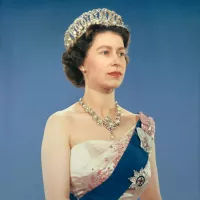
Elizabeth II reigned as Queen of the United Kingdom and...
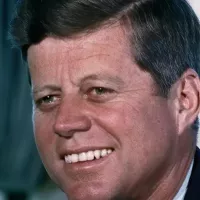
John F Kennedy JFK was the th U S President...
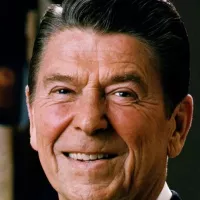
Ronald Reagan the th U S President - was a...
The United States of America is a federal republic located...
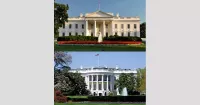
The White House located at Pennsylvania Avenue NW in Washington...
California is a U S state on the Pacific Coast...
Trending

Bo Jackson is a former professional baseball and football player uniquely distinguished as the only athlete named an All-Star in...
2 months ago Apple reportedly delays next iPhone Air release due to disappointing sales performance.
1 month ago Frontier Airlines Introduces Changes, New Routes, and Affordable Travel Options for Passengers.

2 months ago Kalshi Platform Faces Glitches During College Football Games, Disrupting User Orders

6 months ago Drew Carey's 'Price Is Right' buzz: Player wins big, spills secrets, and stuns fans.
2 months ago Prince George's Royal Debut: Joins Kate, King Charles at Remembrance Festival.
Popular

XXXTentacion born Jahseh Dwayne Ricardo Onfroy was a controversial yet...

Ben Shapiro is a prominent American conservative political commentator media...

Candace Owens is an American conservative political commentator and author...

William Franklin Graham III commonly known as Franklin Graham is...
The Kennedy Center Honors are annual awards recognizing individuals and...

Stranger Things created by the Duffer Brothers is a popular...
